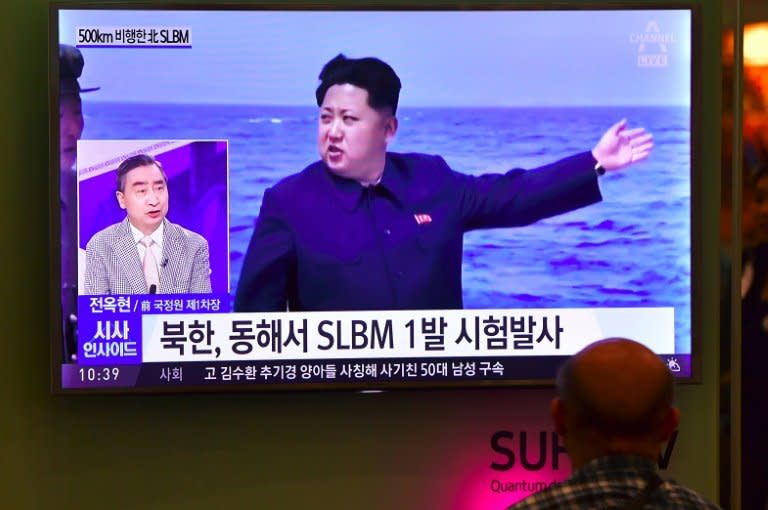North Korea leader says missile test was 'greatest success': KCNA

© AFP Jung Yeon-Je
Seoul (AFP) - North Korean leader Kim Jong-Un has declared a recent submarine-launched ballistic missile (SLBM) test the "greatest success", Pyongyang's state media said on Thursday.
The results of Wednesday's launch proved the North had joined the "front rank of the military powers fully equipped with nuclear attack capability" and that the US mainland and the operational theatre in the Pacific were now "within the striking range" of the North's army, KCNA news agency reported Kim as saying.
The missile flew 500 kilometres (around 300 miles) towards Japan, marking what weapons analysts called a clear step forward for North Korea's nuclear strike ambitions.
Kim saw the launch first hand, KCNA reported, although it was not clear where his alleged observation post was.
A proven SLBM system would take North Korea's nuclear strike threat to a new level, allowing deployment far beyond the Korean peninsula and a "second-strike" capability in the event of an attack on its military bases.
Kim stressed the need for stepped-up efforts to mount nuclear warheads on all types of ballistic missiles and to develop the means to deliver them in order "to cope with the unpredicted total war and nuclear war with the US imperialists", KCNA said.
"I do not guess what ridiculous remarks the US and its followers will make about this test-fire, but I can say their rash acts will only precipitate their self-destruction," Kim was quoted as saying by KCNA.
Kim issued the order for the test-fire, with the submarine rising to a depth suitable for firing and before launching the ballistic missile, the news agency said.
The flight distance, which was tracked by South Korea's military Joint Chiefs of Staff, far exceeded any previous SLBM tests, suggesting significant progress in technical prowess.
South Korea's Yonhap news agency cited a military source as saying Wednesday's launch had been made at an acute angle to limit the missile's range.
If fired at the optimum angle and fully fuelled, it could over 2,500km, the source said.
The agency previously quoted a military source saying if fired atthe optimum angle it could cover more than 1,000km -- without mentioning if it was fully fuelled.
The test-launch proved that "the core technical indexes of the ballistic missile" met "all requirements for operation", KCNA said.
Kim added that the "US vicious nuclear threat and blackmail against the DPRK (North Korea) only resulted in bolstering up its nuclear attack capability hour by hour", according to KCNA.
The South's Joint Chief of Staff said in a statement following the launch that the North was clearly bent on escalating tensions and said the SLBM test posed a "serious challenge" to security on the Korean peninsula.
"We will deal strongly and sternly with any provocation by the North," it said.
Washington also condemned the test and Pentagon spokesman Gary Ross said US commitment to the defence of allies South Korea and Japan remained "ironclad."
Beijing expressed its opposition to North Korea's nuclear and missile development hours after Pyongyang's missile launch.
The UN Security Council met for two hours on Wednesday to discuss the test-firing and agreed to consider a statement condemning the launch.
"There was a general sense of condemnation by most members of the council and therefore we will have to see how we would then be phrasing the press statement," said Malaysia's Ambassador Ramlan bin Ibrahim, who holds this month's council presidency.
The council held the urgent consultations on the event, at the request of the US and Japan.
The latest test came just days after North Korea threatened a pre-emptive nuclear strike against South Korean and US forces who kicked off their annual "Ulchi Freedom" military drill on Monday.
Seoul and Washington insist such joint exercises are purely defensive in nature, but Pyongyang views them as wilfully provocative.
Current UN resolutions prohibit North Korea from any use of ballistic missile technology, but Pyongyang has continued to carry out numerous launches following its fourth nuclear test in January.
South Korea has responded to Pyongyang's continued launches by agreeing to deploy a sophisticated US anti-missile system -- known as THAAD -- a move that has seriously strained relations with North Korea's main diplomatic ally, China.
North Korea has conducted a number of SLBM tests -- most recently in April and July -- with varying degrees of success.
Previous flight distances have not exceeded 30 kilometres, and Seoul's Joint Chiefs of Staff acknowledged that Wednesday's test showed a marked improvement.
See Also:

 Yahoo Finance
Yahoo Finance 
